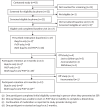Providing medication for opioid use disorder and HIV pre-exposure prophylaxis at syringe services programs via telemedicine: a pilot study
- PMID: 38532395
- PMCID: PMC10967138
- DOI: 10.1186/s12954-024-00983-2
Providing medication for opioid use disorder and HIV pre-exposure prophylaxis at syringe services programs via telemedicine: a pilot study
Abstract
Background: People who inject drugs (PWID) are at high risk for opioid overdose and infectious diseases including HIV. We piloted PARTNER UP, a telemedicine-based program to provide PWID with medication for opioid use disorder (MOUD) with buprenorphine/naloxone (bup/nx) and oral pre-exposure prophylaxis (PrEP) with tenofovir disoproxil fumarate/emtricitabine through two syringe services programs (SSP) in North Carolina. We present overall results from this project, including participant retention rates and self-reported medication adherence.
Methods: Study participants met with a provider for an initial in-person visit at the SSP, followed by weekly telemedicine visits in month 1 and then monthly until program end at month 6. Participants were asked to start both MOUD and PrEP at initiation but could choose to discontinue either at any point during the study. Demographics and health history including substance use, sexual behaviors, and prior use of MOUD/PrEP were collected at baseline. Follow-up surveys were conducted at 3- and 6-months to assess attitudes towards MOUD and PrEP, change in opioid use and sexual behaviors, and for self-reported medication adherence. Participant retention was measured by completion of visits; provider notes were used to assess whether the participant reported continuation of medication.
Results: Overall, 17 persons were enrolled and started on both bup/nx and PrEP; the majority self-identified as white and male. At 3 months, 13 (76%) remained on study; 10 (77%) reported continuing with both MOUD and PrEP, 2 (15%) with bup/nx only, and 1 (8%) with PrEP only. At 6 months, 12 (71%) remained on study; 8 (67%) reported taking both bup/nx and PrEP, and 4 (33%) bup/nx only. Among survey participants, opioid use and HIV risk behaviors decreased. Nearly all reported taking bup/nx daily; however, self-reported daily adherence to PrEP was lower and declined over time. The most common reason for not continuing PrEP was feeling not at risk for acquiring HIV.
Conclusions: Our study results show that MOUD and PrEP can be successfully administered via telemedicine in SSPs. PrEP appears to be a lower priority for participants with decreased continuation and adherence. Low perception of HIV risk was a reason for not continuing PrEP, possibly mitigated by MOUD use. Future studies including helping identify PWID at highest need for PrEP are needed.
Trial registration: Providing Suboxone and PrEP Using Telemedicine, NCT04521920. Registered 18 August 2020. https://clinicaltrials.gov/study/NCT04521920?term=mehri%20mckellar&rank=2 .
Keywords: HIV prevention; Medication assisted treatment; Medication for opioid use disorder; People who inject drugs; Pre-exposure prophylaxis; Substance use disorder; Syringe exchange; Syringe services; Telehealth.
© 2024. The Author(s).
Conflict of interest statement
The authors declare that they have no competing interests.
References
-
- North Carolina Department of Health and Human Services. Opioid and Substance Use Action Plan Data Dashboard. https://www.ncdhhs.gov/opioid-and-substance-use-action-plan-data-dashboard.
-
- North Carolina HIV/STD/Hepatitis Surveillance Unit. 2018 North Carolina HIV Surveillance Report. Raleigh, NC. 2019.
-
- Degenhardt L, Peacock A, Colledge S, Leung J, Grebely J, Vickerman P, et al. Global prevalence of injecting drug use and sociodemographic characteristics and prevalence of HIV, HBV, and HCV in people who inject drugs: a multistage systematic review. Lancet Glob Health. 2017;5(12):e1192–e1207. doi: 10.1016/S2214-109X(17)30375-3. - DOI - PMC - PubMed
Publication types
MeSH terms
Substances
Associated data
Grants and funding
LinkOut - more resources
Full Text Sources
Medical
Miscellaneous


